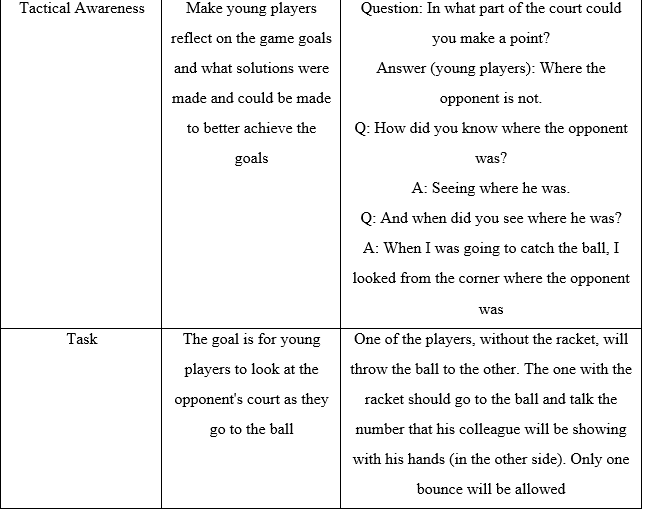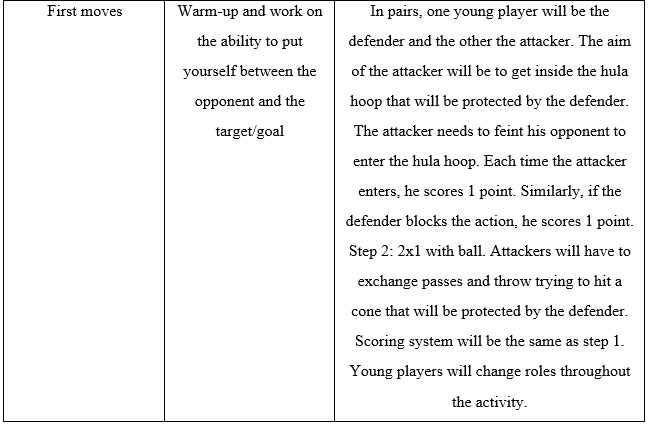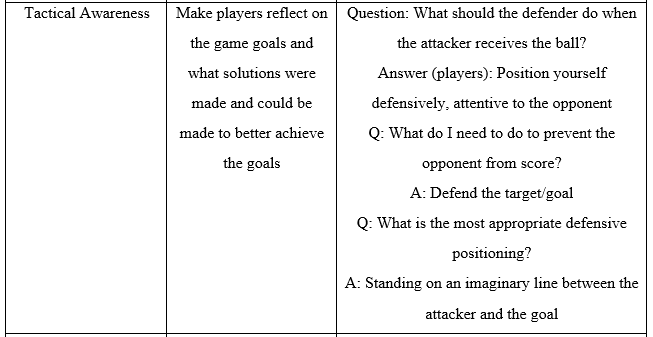[1] Professor at the School of Physical Education, Physiotherapy and Dance of the Federal University of Rio Grande do Sul
ORCID: https://orcid.org/0000-0001-9709-4223
ResearchGate: https://www.researchgate.net/profile/Guy-Ginciene
Twitter: @guy_ginciene
[2] Master degree student on Graduate Program in Human Movement Sciences the at School of Physical Education, Physiotherapy and Dance of the Federal University of Rio Grande do Sul
[3] Master degree student on Graduate Program in Human Movement Sciences the at School of Physical Education, Physiotherapy and Dance of the Federal University of Rio Grande do Sul
[4] Professor at the School of Physical Education, Physiotherapy and Dance of the Federal University of Rio Grande do Sul
ORCID: https://orcid.org/0000-0002-3843-2648
ResearchGate: https://www.researchgate.net/profile/Thiago-Leonardi)
Twitter: @thiagoleonardi
In 2019, we started an extension project called Sports School at the School of Physical Education, Physiotherapy and Dance of the Federal University of Rio Grande do Sul. The aim was to teach sports to children between 6 and 11 years and, at the same time, contribute to the professional development of student-teachers (student of the Physical Education course).
Thus, the project was structured in an action research format, with moments of meetings (reflection) and classes (action) in a spiralling way. The working group was basically formed by two university professors and three student-teachers. One day of the week we met to plan, discuss, reflect, and re-plan the Didactic Unit (DU); and on two other days the student-teachers taught the classes to the children. The project was linked to a research project and therefore the student-teachers recorded their observations in a field diary and excerpts of the classes on their mobile phones through videos/audios.
In 2019, we taught four DUs: one mixed with approximately 10 lessons on invasion and net/wall games; one with 18 classes on net/wall games; one with approximately 10 mixed DU lessons again; and a DU with 20 invasion game lessons.
The classes were developed based on 4 aspects: (a) adaptation of the games to make them possible for the level of young players (smaller courts, adapted rules, smaller and lighter balls, etc.). (ALMOND, 1986; PAES, 2002); (b) majority use of activities with interaction between opponents (respecting the internal logic of invasion games and net/wall games) (GONZÁLEZ; BRACHT, 2012); (c) encouraging young players to reflect and verbalize the tactical-technical solutions to the problems presented by the games (GONZÁLEZ; BRACHT, 2012; KIRK; MACPHAIL, 2002; SARRUGE; GINCIENE; IMPOLCETTO, 2020; THORPE; BUNKER; ALMOND, 1986b); and (d) encouraging the protagonism of young players during the solutions presented by the game (GONZÁLEZ; BRACHT, 2012).
For this, the classes were organized in a format inspired by the model proposed by González, Darido and Oliveira (2017), by the Teaching Games for Understanding (TGfU) (THORPE; BUNKER; ALMOND, 1986a) and Tactical Games Model (MITCHELL; OSLIN; GRIFFIN, 2013). The following script was established: (1) Initial talk; (2) First Movements; (3) Initial Game; (4) Tactical Awareness; (5) Tasks; (6) Final Game.
The Initial Talk (1) opened the lesson, explaining the contents of the day and recalling what had been worked on in the previous meeting. The First Movements (2) concentrated on coordination activities, inspired by the development of the coordination capacity of the "Ball School" (KRÖGER; ROTH, 2005) and the "Universal Sports Initiation" (IEU) (GRECO; BENDA, 1998) considering that the young players had punctual difficulties. The Initial Game (3) was intended to present the tactical problem of that class. For this, tasks that required attention of the young players for one or two tactical principles (GONZÁLEZ; BRACHT, 2012). After the initial game, a moment of Tactical Awareness (4) was held to seek young players’ understanding of what we were wanting to teach. This moment was inspired by the proposal of González, Darido and Oliveira (2017) and the tactical and comprehensive approaches (MITCHELL; OSLIN; GRIFFIN, 2013; THORPE; BUNKER; ALMOND, 1986b). The Tasks (5) were inspired by the tasks proposed in González, Darido and Oliveira (2017). These tasks were intended to train a specific tactical action, according to the purpose of the lesson. The Final Game (6) was similar to the initial game, where the young players could return to the same game and apply what was verbalized in tactical awareness (4) and trained in the task (5).
During the class process, the learning of the young players was evaluated. For this, some strategies were systematically adopted during the year and others were tested in a shorter time. In the two main DU with a single theme (net/wall and invasion, respectively), we used the Game Performance Assessment Instrument (GPAI) (OSLIN; MITCHELL; GRIFFIN, 1998). The categories observed, as well as the criteria used, were based on the specific contents of the class. Three evaluations were performed in each DU mentioned above. In the first DU, the children were evaluated in games of 1 vs 1, in reduced space. The games, regardless of the score, lasted 3 minutes, and were held in three different forms: first without implementing, through the action of grabbing and throwing; the second using hand rackets, made with adapted material; and the last using formal tennis rackets of the children’s size. In the second DU, the children were evaluated in games of 3 vs 3, in reduced space, with two targets (goal scorers), one on each side of the court. The aim was to score goals in the opponent’s target whilst the defenders guarded the target. The games lasted 4 minutes.
Other strategies were used in a formative way, in a shorter time, to monitor young players' learning. One of the strategies was to ask students to draw tactical actions of the game. The drawings, interpreted in the weekly meetings of the research group, showed the amount of detail each child was able to express, giving indications of how they were understanding the game. Another strategy was the creation of an observation form, based on the Team Sport Assessment Procedure (TSAP), in which the young players counted the number of actions of another young player while he/she was on the court. These forms were used throughout the process, as an element of "game observation" related to the role of performance analysts in Sport Education Model. This strategy also contributed to the young players' perception of the tactical actions of the games, as well as evidenced the way the children were able to declare here that they perceived during the games.
ALMOND, Len. Games making. In: THORPE, Rod; BUNKER, David; ALMOND, Len (Eds.). Rethinking games teaching. Leicstershire: Univesity of Loughborough, 1986.
GONZÁLEZ, Fernando Jaime; BRACHT, Valter. Methodology of The Teaching of Collective Sports. Victory: UFES, 2012. .
GONZÁLEZ, Fernando Jaime; DARIDO, Cristina Suraya; OLIVEIRA, Amauri Aparecido Bássoli De. Invasion Sport - 2nd edition. Maringá: Eduem, 2017.
GRECO, Pablo Juan; BENDA, Rodolfo N. Universal sports initiation: from motor learning to technical training. Belo Horizonte: UFMG, 1998. 230 p.
KIRK, David; MACPHAIL, A. Teaching games for understanding and situated learning: Rethinking the Bunker-Thorpe model. Journal of Teaching in Physical Education v. 21, p. 177–192, 2002. Disponível em: <http://ulir.ul.ie/handle/10344/2946>.0273-5024.
KRÖGER, Christian; ROTH, Klaus. Ball School: An ABC for beginners in sports games. São Paulo: Phorte, 2005.
MITCHELL, Stephen A.; OSLIN, Judith L.; GRIFFIN, Linda L. Teaching Sport Concepts and Skills. 3. ed. [S.l.]: Human Kinetics, 2013.
PAES, Roberto Rodrigues. School Physical Education: sport as pedagogical content of elementary school. Canoes: Ulbra Publishing House, 2002.
SARRUGE, Lara Carina; GINCIENE, Guy; IMPOLCETTO, Fernanda Moreto. Teaching the logic of volleyball game: a proposal from teaching games for understanding and the use of technologies. Movement (ESEF/UFRGS) v. 26, p. 1–14, 2020.
THORPE, Rod; BUNKER, D; ALMOND, L. Rethinking games teaching. Leicstershire: Univesity of Loughborough, 1986a. 79 p. An attempt to influence the way games are taught, aimed directly at teachers and the way they teach.
THORPE, Rod; BUNKER, David; ALMOND, Len. Rethinking games teaching. [S.l.]: Department of Physical Education and Sports Science, University of Technology, 1986b.











